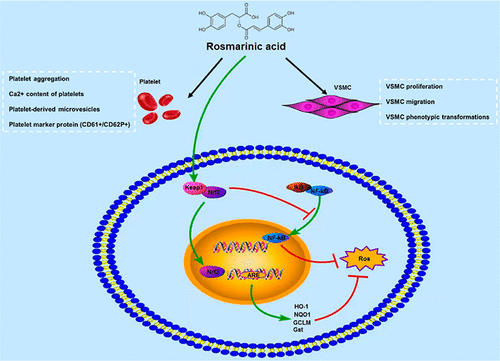当前位置:
X-MOL 学术
›
J. Agric. Food Chem.
›
论文详情
Our official English website, www.x-mol.net, welcomes your
feedback! (Note: you will need to create a separate account there.)
Rosmarinic Acid Inhibits Platelet Aggregation and Neointimal Hyperplasia In Vivo and Vascular Smooth Muscle Cell Dedifferentiation, Proliferation, and Migration In Vitro via Activation of the Keap1-Nrf2-ARE Antioxidant System
Journal of Agricultural and Food Chemistry ( IF 5.7 ) Pub Date : 2022-06-10 , DOI: 10.1021/acs.jafc.2c01176 Chen Chen 1 , Jiulong Ma 2 , Zhiping Xu 1 , Liang Chen 1 , Bo Sun 2 , Yan Shi 2 , Yujia Miao 1 , Tianlong Wu 1 , Meng Qin 3 , Yang Zhang 2 , Ming Zhang 2 , Xia Cao 1
Journal of Agricultural and Food Chemistry ( IF 5.7 ) Pub Date : 2022-06-10 , DOI: 10.1021/acs.jafc.2c01176 Chen Chen 1 , Jiulong Ma 2 , Zhiping Xu 1 , Liang Chen 1 , Bo Sun 2 , Yan Shi 2 , Yujia Miao 1 , Tianlong Wu 1 , Meng Qin 3 , Yang Zhang 2 , Ming Zhang 2 , Xia Cao 1
Affiliation

|
The activation of platelets and proliferation of vascular smooth muscle cells (VSMCs) in the vascular intima play an essential role in the pathological mechanism of vascular restenosis (RS). Rosmarinic acid (RA) is a natural phenolic acid compound. However, its mechanism of action on platelets and VSMCs is still unclear. This study investigated the effects of RA on platelet function, VSMCs phenotypic conversion, proliferation, and migration in vascular remodeling with a specific focus on the Keap1-Nrf2-ARE signaling pathway. RA inhibited platelet aggregation and Ca2+ release and significantly reduced the release of platelet microvesicles. In addition, RA inhibited the phenotypic transition of VSMCs in vitro and in vivo. In vitro experiments showed that RA could effectively inhibit the proliferation and migration of VSMCs induced by the platelet-derived growth factor (PDGF)-BB. PDGF-BB triggered ROS generation and a decrease in mitochondrial membrane potential, which were inhibited by RA. Mechanistically, after artery injury or treatment with PDGF-BB, VSMCs presented with inhibition of the Nrf2/antioxidant response element (ARE) signaling pathway. RA treatment reversed this profile by activating the Nrf2/ARE signaling pathway; stabilizing Keap1 protein; upregulating HO-1, NQO1, GCLM, and GST protein levels; promoting typical Nrf2 nuclear translocation; and preventing VSMCs from oxidative stress damage. On the other hand, RA also inhibited the NF-κB pathway to reduce inflammation. In summary, these results indicate that RA inhibits platelet function and attenuates the proliferation, migration, and phenotypic transition of VSMCs induced by PDGF-BB in vitro and vascular remodeling in vivo. Therefore, RA treatment may be a potential therapy for preventing or treating RS.
中文翻译:

迷迭香酸通过激活 Keap1-Nrf2-ARE 抗氧化系统抑制体内血小板聚集和新内膜增生以及体外血管平滑肌细胞去分化、增殖和迁移
血管内膜中血小板的活化和血管平滑肌细胞(VSMC)的增殖在血管再狭窄(RS)的病理机制中发挥着重要作用。迷迭香酸(RA)是一种天然酚酸化合物。然而,其对血小板和VSMC的作用机制仍不清楚。本研究调查了 RA 对血管重塑中血小板功能、VSMC 表型转换、增殖和迁移的影响,特别关注 Keap1-Nrf2-ARE 信号通路。 RA抑制血小板聚集和Ca 2+释放并显着减少血小板微泡的释放。此外,RA在体外和体内抑制VSMCs的表型转变。体外实验表明,RA能有效抑制血小板源性生长因子(PDGF)-BB诱导的VSMCs增殖和迁移。 PDGF-BB 触发 ROS 生成和线粒体膜电位降低,而这被 RA 抑制。从机制上讲,动脉损伤或 PDGF-BB 治疗后,VSMC 表现出 Nrf2/抗氧化反应元件 (ARE) 信号通路的抑制。 RA 治疗通过激活 Nrf2/ARE 信号通路逆转了这种情况;稳定 Keap1 蛋白;上调 HO-1、NQO1、GCLM 和 GST 蛋白水平;促进典型的Nrf2核易位;并防止 VSMC 免受氧化应激损伤。另一方面,RA还抑制NF-κB通路以减轻炎症。总之,这些结果表明,RA 抑制血小板功能,并减弱 PDGF-BB 体外诱导的 VSMC 的增殖、迁移和表型转变以及体内血管重塑。 因此,RA治疗可能是预防或治疗RS的潜在疗法。
更新日期:2022-06-10
中文翻译:

迷迭香酸通过激活 Keap1-Nrf2-ARE 抗氧化系统抑制体内血小板聚集和新内膜增生以及体外血管平滑肌细胞去分化、增殖和迁移
血管内膜中血小板的活化和血管平滑肌细胞(VSMC)的增殖在血管再狭窄(RS)的病理机制中发挥着重要作用。迷迭香酸(RA)是一种天然酚酸化合物。然而,其对血小板和VSMC的作用机制仍不清楚。本研究调查了 RA 对血管重塑中血小板功能、VSMC 表型转换、增殖和迁移的影响,特别关注 Keap1-Nrf2-ARE 信号通路。 RA抑制血小板聚集和Ca 2+释放并显着减少血小板微泡的释放。此外,RA在体外和体内抑制VSMCs的表型转变。体外实验表明,RA能有效抑制血小板源性生长因子(PDGF)-BB诱导的VSMCs增殖和迁移。 PDGF-BB 触发 ROS 生成和线粒体膜电位降低,而这被 RA 抑制。从机制上讲,动脉损伤或 PDGF-BB 治疗后,VSMC 表现出 Nrf2/抗氧化反应元件 (ARE) 信号通路的抑制。 RA 治疗通过激活 Nrf2/ARE 信号通路逆转了这种情况;稳定 Keap1 蛋白;上调 HO-1、NQO1、GCLM 和 GST 蛋白水平;促进典型的Nrf2核易位;并防止 VSMC 免受氧化应激损伤。另一方面,RA还抑制NF-κB通路以减轻炎症。总之,这些结果表明,RA 抑制血小板功能,并减弱 PDGF-BB 体外诱导的 VSMC 的增殖、迁移和表型转变以及体内血管重塑。 因此,RA治疗可能是预防或治疗RS的潜在疗法。











































 京公网安备 11010802027423号
京公网安备 11010802027423号